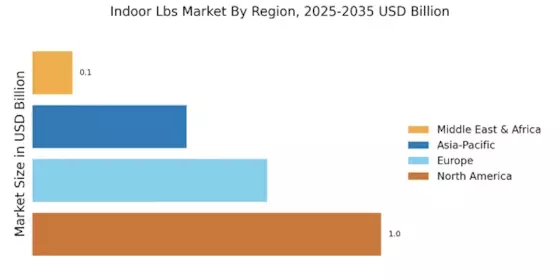Advancements in Sensor Technology
The Indoor Lbs Market is significantly influenced by advancements in sensor technology, which enhance the accuracy and reliability of indoor positioning systems. Innovations in Bluetooth Low Energy (BLE), Wi-Fi, and ultra-wideband (UWB) technologies are transforming how indoor navigation is implemented. These technologies enable precise tracking of assets and individuals within complex environments, such as airports and shopping malls. The integration of advanced sensors allows for real-time data collection and analysis, which is crucial for applications in emergency response and facility management. As sensor technology continues to evolve, the Indoor Lbs Market is likely to witness increased adoption rates, as businesses seek to implement more sophisticated and efficient location-based solutions.
Increased Focus on Safety and Security
The Indoor Lbs Market is also shaped by an increased focus on safety and security measures within various establishments. Organizations are increasingly adopting indoor positioning systems to enhance security protocols and ensure the safety of individuals in public spaces. For instance, in large venues such as stadiums and shopping centers, indoor Lbs solutions can facilitate efficient crowd management and emergency response. The integration of location-based technologies allows for real-time monitoring and alerts, which are essential for maintaining safety standards. As safety concerns continue to rise, the Indoor Lbs Market is likely to see a growing demand for solutions that prioritize security and emergency preparedness.
Rising Demand for Location-Based Services
The Indoor Lbs Market experiences a notable surge in demand for location-based services across various sectors, including retail, healthcare, and logistics. As businesses increasingly recognize the value of precise indoor positioning, the market is projected to grow significantly. According to recent estimates, the market for indoor positioning and navigation solutions is expected to reach a valuation of approximately 40 billion dollars by 2026. This growth is driven by the need for enhanced customer experiences and operational efficiencies. Retailers, for instance, leverage indoor location data to optimize store layouts and improve customer engagement. Consequently, the Indoor Lbs Market is poised to benefit from this trend, as organizations seek to harness location data to drive strategic decision-making.
Growing Adoption of Smart Building Solutions
The Indoor Lbs Market is experiencing a shift towards smart building solutions, which integrate various technologies to enhance operational efficiency and user experience. As organizations invest in smart infrastructure, the demand for indoor positioning systems is expected to rise. Smart buildings utilize sensors and IoT devices to monitor and manage resources effectively, leading to improved energy efficiency and reduced operational costs. According to industry reports, the smart building market is anticipated to grow at a compound annual growth rate of over 10% in the coming years. This trend indicates a strong correlation between smart building initiatives and the Indoor Lbs Market, as businesses increasingly seek to leverage location data for better resource management and user engagement.
Regulatory Support and Standardization Efforts
The Indoor Lbs Market is benefiting from regulatory support and standardization efforts aimed at promoting the adoption of indoor positioning technologies. Governments and industry bodies are increasingly recognizing the importance of location-based services in enhancing public safety and operational efficiency. Initiatives to establish standards for indoor positioning systems are underway, which could facilitate interoperability and encourage wider adoption across various sectors. This regulatory landscape is expected to foster innovation and investment in the Indoor Lbs Market, as businesses seek to comply with emerging standards and leverage location data for competitive advantage. The alignment of regulatory frameworks with technological advancements may further accelerate market growth.


















Leave a Comment